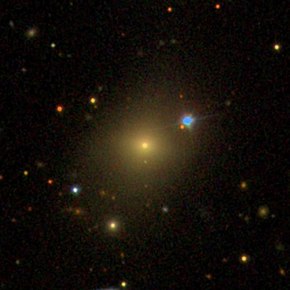
Back NGC 6047 Arabic NGC 6047 (مجره) ARZ NGC 6047 Azerbaijani NGC 6047 Byelorussian NGC 6047 BS NGC 6047 CE NGC 6047 German NGC 6047 DIQ NGC 6047 Esperanto NGC 6047 Basque
| NGC 6047 | |
|---|---|
 SDSS image of NGC 6047. | |
| Observation data (J2000 epoch) | |
| Constellation | Hercules |
| Right ascension | 16h 05m 09.0s[1] |
| Declination | 17° 43′ 48″[1] |
| Redshift | 0.031262[1] |
| Heliocentric radial velocity | 9,372 km/s[1] |
| Distance | 131.4 Mpc (429 Mly)[1] |
| Group or cluster | Hercules Cluster |
| Apparent magnitude (V) | 14.55[1] |
| Characteristics | |
| Type | E+, cD[1] |
| Size | ~170 kly (52 kpc)[1] (estimated)[1] |
| Apparent size (V) | 1′.1 x 0′.8[1] |
| Notable features | radio jet |
| Other designations | |
| CGCG 108-111, DRCG 34-62, 4C +17.66, PKS 1602+178, MCG +3-41-87, PGC 57033[1] | |
NGC 6047 is an elliptical galaxy located about 430 million light-years away[2] in the constellation Hercules.[3] It was discovered by astronomer Lewis Swift on June 27, 1886.[4] NGC 6047 is a member of the Hercules Cluster.[5][6][7]
NGC 6047 has a peculiar morphology[5][8][9] which suggests it has undergone a recent merger.[6][7][10] It may be interacting with NGC 6045 which lies around ~320,000 ly (97 kpc) away.[8] NGC 6047 has two radio jets[6][7] and is classified as a FR I radio galaxy.[9] The jets appear to have a Z-shaped structure.[5]
- ^ a b c d e f g h i j k "NASA/IPAC Extragalactic Database". Results for NGC 6047. Retrieved 2018-08-16.
- ^ "Your NED Search Results". ned.ipac.caltech.edu. Retrieved 2018-08-20.
- ^ "Revised NGC Data for NGC 6047". spider.seds.org. Retrieved 2018-08-21.
- ^ "New General Catalog Objects: NGC 6000 - 6049". cseligman.com. Retrieved 2018-08-21.
- ^ a b c Feretti, L.; Giovannini, G. (February 1988). "NGC 6047 - Radio source interaction with the environment". Astronomy and Astrophysics. 191: 21. Bibcode:1988A&A...191...21F. ISSN 0004-6361.
- ^ a b c Liuzzo, E.; Giovannini, G.; Giroletti, M.; Taylor, G. B. (June 2010). "Parsec-scale properties of brightest cluster galaxies". Astronomy and Astrophysics. 516: A1. arXiv:1002.1380. Bibcode:2010A&A...516A...1L. doi:10.1051/0004-6361/200913888. ISSN 0004-6361. S2CID 14536396.
- ^ a b c Liuzzo, E.; Giovannini, G.; Giroletti, M. (March 2011). "Nuclear properties of Brightest Cluster Galaxies: results and new observations for two peculiar cases". arXiv:1103.0450 [astro-ph.CO].
- ^ a b Huang, Zhenping; Sarazin, Craig L. (April 1996). "A High-Resolution ROSAT X-Ray Study of the Hercules Cluster". The Astrophysical Journal. 461: 622. Bibcode:1996ApJ...461..622H. doi:10.1086/177090. ISSN 0004-637X.
- ^ a b Heckman, T. M.; Smith, Eric P.; Baum, Stefi A.; van Breugel, W. J. M.; Miley, G. K.; Illingworth, G. D.; Bothun, G. D.; Balick, B. (December 15, 1986). "Galaxy collisions and mergers - The genesis of very powerful radio sources?". The Astrophysical Journal. 311: 526–547. Bibcode:1986ApJ...311..526H. doi:10.1086/164793. ISSN 0004-637X.
- ^ Dickey, John M. (June 1997). "A VLA Survey of the Hercules Cluster.I.The HI Data". The Astronomical Journal. 113: 1939. Bibcode:1997AJ....113.1939D. doi:10.1086/118408. ISSN 0004-6256.